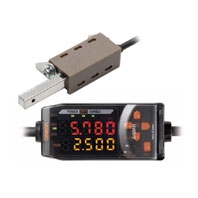| Model |
ZJ-SDA11 |
| Measurement period |
1 ms |
Possible average count
settings *1 |
1, 2, 4, 8, 16, 32, 64, 128, 256, 512, or 1,024 |
| Linear output *2 |
Current output: 4 to 20 mA/FS, Max. load resistance: 300 Ω
Voltage output: ±4 V (±5 V, 1 to 5 V *3), Output impedance: 100 Ω |
Judgment outputs
(3 outputs: OPE1, OPE2,
and OPE3) |
NPN open-collector output, 30 VDC, 20 mA max.
Residual voltage: 1.2 V max. |
Bank shift input, zero reset
input, timing input, reset
input |
ON: Short-circuited with 0-V terminal or 1.5 V or less
OFF: Open (leakage current: 0.1 mA max.) |
| Functions |
Measurement value display, display reverse, scaling, peak and bottom hold, distance
compensation, present value display, limit number of display digits, monitor focus,
mask hold, sensing area compensation, output value display, zero reset, linear output
compensation, distance trigger, warning output, setting value display, zero reset
memory, peak hold, delay hold, bank switching, resolution display, various timers,
bottom hold, delay time setting, enable display, initialization, sample hold, timing inputs,
zero reset display, teaching, peak-to-peak, key lock, judgment output display, direct
threshold value setting, hold, clamp value setting, ECO mode, hysteresis adjustment,
average hold, precise measurement mode |
| Indications |
Operation indicators (OPE1 (orange), OPE2 (green), OPE3 (yellow), 7-segment main
digital display (red), 7-segment sub-digital display (yellow), power ON indicator (green),
zero reset indicator (green), enable indicator (green) |
| Power supply voltage |
24 VDC ±10%, Ripple (p-p): 10% max. |
| Current consumption |
24-VDC power supply: 140 mA max. |
| Ambient temperature range |
Operating and storage: 0 to 50°C (with no icing or condensation) |
| Ambient humidity range |
Operating and storage: 35% to 85% (with no condensation) |
| Insulation resistance |
20 MΩ (at 500 VDC) |
| Dielectric strength |
1,000 VAC, 50/60 Hz, 1 min |
| Shock resistance |
Destruction: 300 m/s2 3 times each in 6 directions (up/down, left/right, and forward/
backward) |
| Vibration resistance |
Destruction: 0.7-mm double amplitude at 10 to 150 Hz for 80 min each in the X, Y, and
Z directions |
| Connecting method |
Pre-wired (standard length: 2 m) |
| Weight (packed state) |
Approx. 350 g |
| Materials |
Case: PBT (polybutylene terephthalate), Cover: Polycarbonate |
| Accessories |
Instruction sheet |



